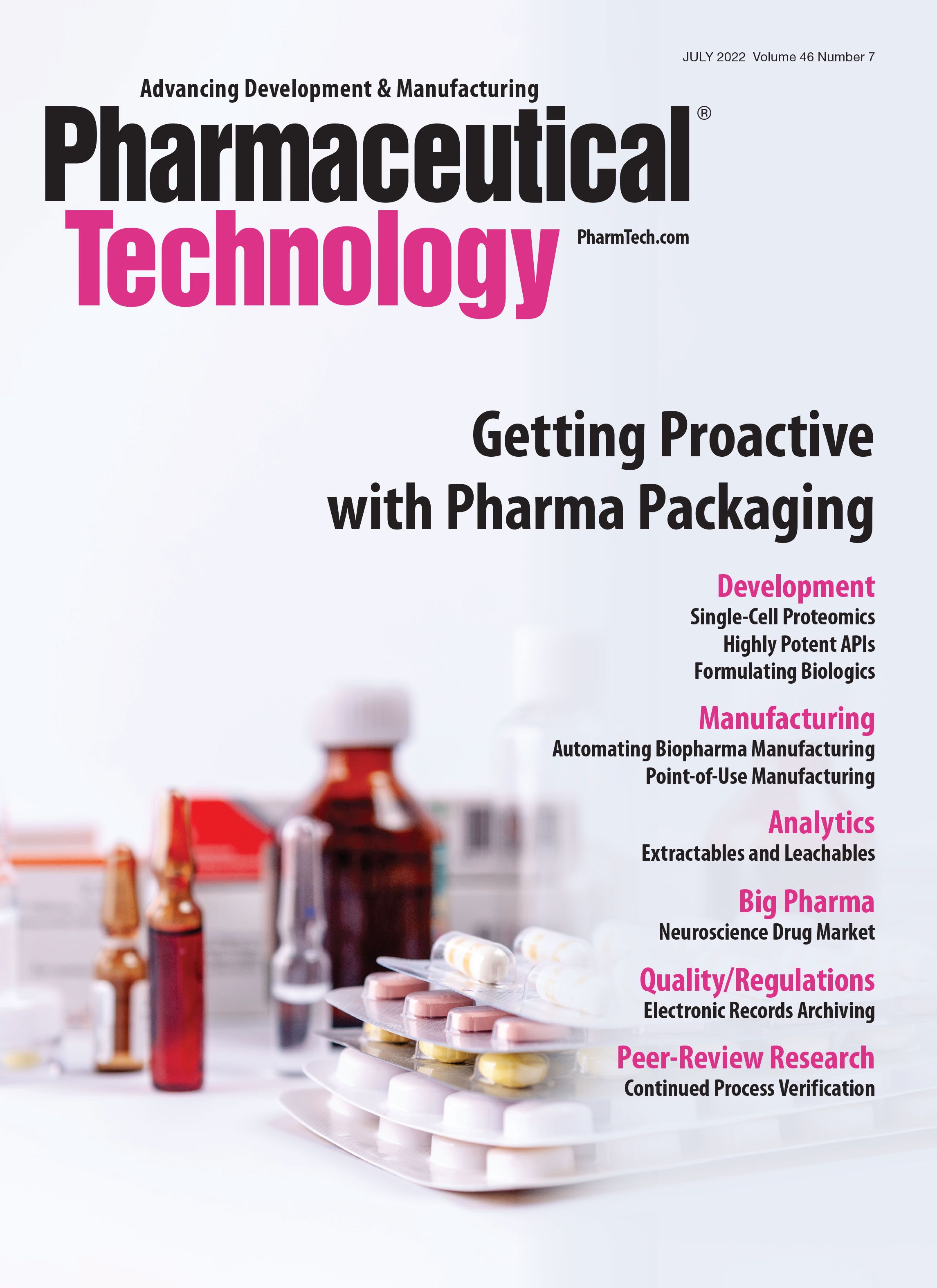Formulating Biologics: A Learning Curve
Biologics are forming a greater proportion of the development pipeline, but there are still some formulation difficulties to overcome to ensure clinical and commercial success.
IGOR KISSELEV - STOCK.ADOBE.COM

The total pharma development pipeline is set to exceed 20,000 drug candidates in 2022, which has grown by 8.22% and seen more than 1500 new drugs added to the pipeline from the prior year (1). When looking at biological versus non-biological drugs, there has been more ground gain for the former type of drug in the pipeline with the proportions coming close to 50:50—biologics are now consuming 44.7% of the development pipeline (1).
This strong development pipeline representation is also translating into impressive growth for the biologics market, which is projected to grow at a rate of 10.7% annually up until 2025 and then 9.6% annually from 2025 until 2030 (2). Driving this growth are factors such as an increasingly geriatric population, rising need for immunology, and more government initiatives (2).
However, the majority of the pipeline drugs are still in preclinical phases (1), which means there are still attrition rates to be wary of and some work to be done for commercial success to be achieved. Formulating a biologic drug is a potentially problematic area, as the molecules are inherently large and complex, and also have stability issues to overcome.
“For a successful biological formulation, choosing the right formula and a process that will ensure the biological stability and activity while also maintaining sufficient drug concentration without aggregation is key,” explains Jim Huang, PhD, founder and CEO of Ascendia Pharmaceuticals. “And using the correct drug delivery system to deliver the biologicals to the target organ while minimizing enzymatic degradation during body circulation in vivo is also important.”
Common issues
A common issue encountered when developing biologics is degradation, which can occur due to changes in a variety of external factors, such as temperature and pH. Huang stresses that many formulation errors can occur due to insufficient studies being performed “to test the biologicals under a variety of physical and chemical stresses in order to provide a good understanding of the degradation products and mechanism.”
Although regulatory bodies demand stress testing be performed on all drug substances and drug products, there aren’t well established selection protocols for such tests available (3). This is an area where an outsourcing partner can prove invaluable, as they have access to a greater pool of knowledge and experience than a company typically would in-house.
“Outsourcing partners should not only function as an extension of the client’s chemistry, manufacturing, and control labs, but also can contribute to its in-house proprietary technologies, formulation skills, and know-how to address the issues arising from the development process of complex biologicals,” Huang adds.
Delivering the goods
Delivering a drug effectively is key, and, nowadays there are many possibilities for developers to explore. “Non-vector drug delivery technologies such as lipid nanoparticles or polymeric nanoparticles have been applied to delivery of biologicals,” says Huang. “For example, lipid nanoparticle technology has made delivery of COVID-19 vaccines possible.”
“There is a tendency to use more complex drug delivery technologies to address the complex nature of biologicals,” Huang continues. “For example, Ascendia has started to use long acting injectable, in-situ depot, lipid nanoparticles, liposome, and polymeric nano/microparticles to deliver biologicals in order to achieve the pharmacokinetic profiles requested for the biologicals.”
However, nanoparticles are not without their own challenges—safety being a major consideration to factor in (4). When combining a drug with a nanoparticle carrier, it is important to understand whether or not the carrier will impart some side effects for the patient in addition to the potential effects of the active molecule.
The route of administration is, of course, an important factor when considering the delivery of a drug. For the most part, biologic therapies are developed as injectable formulations, mainly because the molecules have poor permeability across the mucosal layer and suffer destruction when introduced to the gastrointestinal (GI) tract (5). However, for patients, non-invasive routes of administration, such as oral, are preferred.
On the matter of oral administration of biologics, Huang points out that it is possible and alludes to the fact that Ascendia has successfully delivered biological-like molecules orally via its EmulSol technology, which increases the molecular bioavailability. “Key to the success of orally administered biologicals is to protect them from GI tract degradation and to enhance the permeability of the biologicals through GI gut membrane,” he summarizes.
References
1. Citeline Pharma Intelligence, Pharma R&D Annual Review 2022 Navigating the Landscape, White Paper, Informa (May 2022).
2. Research and Markets, ~, Market Report (February 2022).
3. E. Tamizi and A. Jouyban, Eur. J. Pharm Biopharm., 98, 24–46 (2016).
4. M. May, Nat. Med., 28, 1100–1102 (2022).
5. B. Homayun, X. Lin, and H.-J. Choi, Pharmaceutics, 11 (3) 129 (2019).
About the author
Felicity Thomas is the European/senior editor for Pharmaceutical Technology Group.
Article details
Pharmaceutical Technology
Vol. 46, No. 7
July 2022
Pages: 28–29
Citation
When referring to this article, please cite it as F. Thomas, “Formulating Biologics: A Learning Curve,” Pharmaceutical Technology 46 (7) 2022.

Drug Solutions Podcast: A Closer Look at mRNA in Oncology and Vaccines
April 30th 2024In this episode fo the Drug Solutions Podcast, etherna’s vice-president of Technology and Innovation, Stefaan De Koker, discusses the merits and challenges of using mRNA as the foundation for therapeutics in oncology as well as for vaccines.
Drug Solutions Podcast: Applying Appropriate Analytics to Drug Development
March 26th 2024In this episode of the Drug Solutions Podcast, Jan Bekker, Vice President of Business Development, Commercial and Technical Operations at BioCina, discusses the latest analytical tools and their applications in the drug development market.
INTERPHEX 2025: Use of Walk-In Chambers for Bio/Pharma Development and Manufacturing
April 2nd 2025Sitting down with the PharmTech Group at INTERPHEX 2025, Christopher Murphy, director of Global Business Development and Service Customer Support at Environmental Specialties, discusses the design and critical role of walk-in chambers in the bio/pharmaceutical industry.